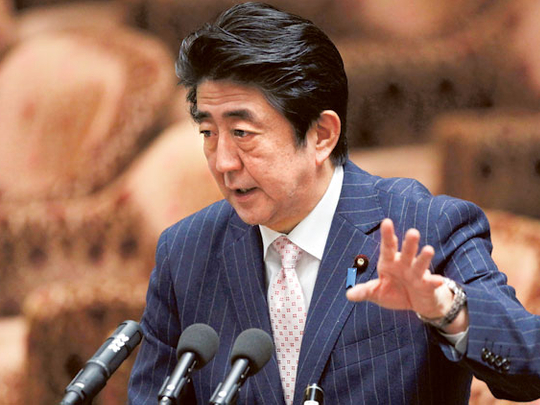
Tokyo: The widening of Japan’s trade deficit to an unprecedented 2.79 trillion yen (Dh100 billion, $27.4 billion) in January — more than Y1tn larger than the previous record — underscores a painful structural shift for an economy that has long relied on exports to drive its growth.
For economists who follow Japan, the phenomenon might be called the case of the missing J-curve.
When the yen began falling sharply in late 2012, menaced by the threat of devaluation from Shinzo Abe, the soon-to-be prime minister, it made imports more expensive and dragged an already sizeable trade deficit more deeply into negative territory.
That is exactly what economic textbooks predict would happen.
But theory, and past experience in Japan, suggested things would quickly turn around: consumers would respond to the rising cost of foreign goods by buying fewer of them, while Japan’s own exports would become more competitive. Before long, the initial deterioration would be followed by an even more pronounced improvement — economists’ “J”-shaped curve.
Yet that has not happened. Instead, imports have continued to bound ahead of exports, creating ever-widening trade deficits and leaving Japan’s Abenomics recovery — the roughly year-old spurt of economic growth that has coincided with Mr Abe’s expansionary policies — reliant on domestic spending. Quarterly gross domestic product data released on Monday showed output failed to regain momentum at the end of 2013, as many economists had expected it would, largely as a result of weak net exports.
“There has been no J-curve,” says one economist close to the government. “It’s been very surprising. We may need to consider whether there’s been a deeper change in the economy, one that means the old assumptions about the costs and benefits of a weak yen don’t apply any more.”
Another economist, Kazuhito Ikeo of Keio University, says Mr Abe’s government “looked at past examples and thought that weakening the yen would lift exports and the economy. But it hasn’t been that simple.”
The weak yen has still been a boon for companies that sell a lot of goods in dollars, euros and other currencies, and the resulting surge in their share prices has made investors richer and encouraged consumer spending. Yet the recovery’s lopsidedly domestic base leaves it in a potentially precarious state, experts say, particularly given an impending increase in Japan’s national sales tax.
The rise, from 5 to 8 per cent, is likely to hurt consumption after it takes effect in April, and though most economists think Japan will avoid a recession — its fate after the tax was raised the last time, in 1997 — the lack of a cushion from exports is a concern.
Japan’s spending on imports began persistently exceeding the value of its exports after the 2011 Fukushima nuclear accident, which led to the shutdown of atomic power plants across the country and forced up purchases of foreign oil and gas.
The high proportion of energy in Japan’s imports may be one factor preventing the J-curve from taking shape, experts say. Rising electricity prices have been painful for many, but have not prompted a widespread shift to Amish-style living. Even finding alternatives to the grid can require importing, at least at first: sales of Chinese-made solar cells rose enough in January to add to the trade deficit, according to government data.
A spike in consumer demand ahead of the sales-tax hike is also supporting imports and widening the trade deficit, economists say. That is likely to subside after April, though at a cost to overall economic activity, since the tax rise will hit consumption of domestically produced goods as much as foreign ones.
On the export side, many point to the declining competitiveness of Japan’s consumer electronics industry and a steady outflow of manufacturing capacity to foreign countries. Global companies still enjoy rising profits when the yen falls — Toyota, for instance, expects to earn a record Y1.9tn this financial year — but the boost comes less from growing exports than the ability to repatriate foreign sales at more advantageous exchange rates.
January’s trade accounts, announced by the finance ministry on Thursday, showed the 19th deficit in a row and the largest since at least 1979, when comparable records began. The previous record, of Y1.63tn, had been set a year earlier, in January 2013.
Exports actually declined by volume in January, for the first time in four months, a fall that was partly blamed on lower demand in China during the lunar new year. Imports rose 8 per cent by volume compared with the same month a year earlier, but, thanks to the yen, the national import bill was one-quarter higher.
Not everyone has given up on the J-curve. Kazuhiko Baba, chief Japan economist at Goldman Sachs, expects “a gradual improvement [in the trade balance] over time in line with the J curve effect”. Still, he also sees “structural changes in imports” as Japanese buy not only more oil, gas and other products that have historically sourced from abroad, but formerly domestic specialities such as electronics.
— Financial Times










